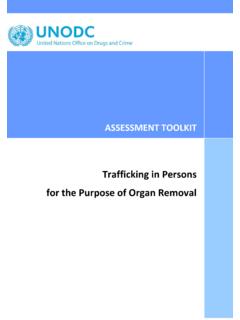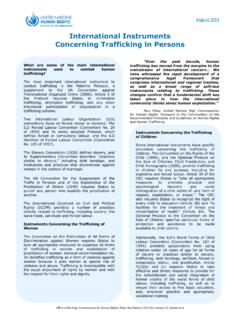Transcription of Handbook for the Protection of Internally Displaced Persons
1 PR. O. RE VI. LE SIO. AS NA. E L. Provisional Release Global Protection Cluster Working Group December 2007. Acknowledgements This Provisional Edition of the Handbook for the Protection of Internally Displaced Persons is the result of a collaborative effort involving a large number of colleagues serving in United Nations agencies, international organizations, non-governmental organizations and other humanitarian actors, including: n Austcare n Centre for Humanitarian Dialogue (CHD). n Christian Children's Fund (CCF). n Danish Refugee Council (DRC). n Geneva Centre for the Democratic Control of Armed Forces (DCAF). n Global Camp Management and Camp Coordination (CCCM) Cluster n HelpAge International n International Organization for Migration (IOM). n InterAction (American Council for Voluntary International Action). n Internal Displacement Monitoring Centre (IDMC/NRC). n International Labour Organisation (ILO). n International Rescue Committee (IRC). n Jesuit Refugee Service (JRS).
2 N Norwegian Refugee Council (NRC). n Office of the United Nations High Commissioner for Human Rights (OHCHR). n United Nations Office for the Coordination of Humanitarian Affairs (OCHA). n Representative of the Secretary-General on the Human Rights of Internally Displaced Persons (RSG-IDP). n Save the Children International n The Shelter Centre n United Nations Children's Fund (UNICEF). n United Nations Development Programme (UNDP). n United Nations High Commissioner for Refugees (UNHCR). n United Nations Human Settlements Programme (UN-HABITAT). n United Nations Mine Action Service (UNMAS). n Women's Commission on Refugee Women and Children n World Food Programme (WFP). The International Committee of the Red Cross (ICRC) also provided much valued advice and support. UNHCR facilitated the process in coordination with the Global Protection Cluster Working Group (PCWG). Geneva, December 2007. iii Handbook for the Protection of Internally Displaced Persons List of Abbreviations International and Regional Legal Instruments International Human Rights Law CAT convention against Torture and Other Cruel, Inhuman or Degrading Treatment or Punishment (1984).
3 CED International convention for the Protection of All Persons from Enforced Disappearances (2007). CEDAW convention on the Elimination of All Forms of Discrimination against Women (1979). CMW International convention on the Protection of the Rights of All Migrant Workers and Members of Their Families (1990). CPD convention on the Rights of Persons with Disabilities (2006). CPPCG convention on the Prevention and Punishment of the crime of Genocide (1948). CRC convention on the Rights of the Child (1989). CRSS convention Relating to the Status of Stateless Persons (1954). CRS convention on the Reduction of Statelessness (1961). ICCPR International Covenant on Civil and Political Rights (1966). ICERD International convention on the Elimination of All Forms of Racial Discrimination (1965). ICESCR International Covenant on Economic, Social and Cultural Rights (1966). Trafficking in Protocol to Prevent, Suppress and Punish Trafficking in Persons , Persons Protocol Especially Women and Children, Supplementing the United Nations convention Against transnational organized crime (2000).
4 UDHR Universal Declaration of Human Rights (1948). Regional Human Rights Law AmCHR American convention on Human Rights (1992). AmDHR American Declaration of the Rights and Duties of Man (1948). AfCHPR African [Banjul] Charter on Human and Peoples' Rights (1981). AfCRWC African Charter on the Rights and Welfare of the Child (1990). ArCHR Arab Charter on Human Rights, Council of the League of Arab States (1994). Cairo Declaration Cairo Declaration on Human Rights in Islam (1990). ECHR European convention for the Protection of Human Rights and Fundamental Freedoms (European convention on Human Rights). (1950). iv International Criminal Law ICC Statute/ Statute of the International Criminal Court (1998). Rome Statute ICTR Statute Statute of the International Tribunal for Rwanda (1994). ICTY Statute Statute of the International Tribunal for the Former Yugoslavia (1993). International Humanitarian Law CCW 1980 United Nations convention on Prohibitions or Restrictions on the Use of Certain Conventional Weapons Which May be Deemed to be Excessively Injurious or to Have Indiscriminate Effects.
5 Hague convention (IV) respecting the Laws and Customs of War on Land and convention IV its annex: Regulations concerning the Laws and Customs of War on Land (1907). Hague Regulations Respecting the Laws and Customs of war on Land Regulations annexed to Hague convention (II) of 1899 and Hague convention (IV). of 1907. v Handbook for the Protection of Internally Displaced Persons Table of Contents Introduction Introduction to the provisional edition of the Handbook ..1. Part I: 1. The fundamentals of Protection work ..5. Foundations 2. The legal framework for the Protection of Internally Displaced of IDP Protection 3. The international institutional framework ..35. Part II: 1. Attitudes ..51. Attitudes 2. Skills ..55. and Skills 3. Working with the Part III: Building a 1. Situational Strategic 2. Developing the Protection 3. Monitoring and evaluation ..86. Response 4. Part IV: Activities 1. Protection and Tools 2. Humanitarian access and presence ..98. for 3.
6 Advocacy ..103. Protection 4. Capacity-building ..108. (Guidance 5. Legal Notes) 6. Disseminating information ..120. 7. Humanitarian assistance ..125. 8. Profiling of Internally Displaced Persons ..131. 9. Humanitarian evacuations ..137. 10. Community mobilization ..143. 11. Mental health and psychosocial support ..149. 12. Coordination and management of camps and collective settings ..154. Part V: Protection 1. Forced and unlawful displacement ..164. Risks: 2. Civil status and the prevention of Prevention, 3. Life, safety and mitigation 4. Gender-based violence ..194. and 5. Children associated with armed forces / response 6. Mines and explosive remnants of war ..212. (Action 7. Human Sheets) 8. Liberty and freedom of movement ..224. 9. Family unity ..231. 10. Access to 11. Land and property ..255. 12. Political 13. Shelter ..269. 14. 15. Health ..287. 16. 17. 18. Food aid and 19. Water and Part VI: 1. Durable solutions in the context of internal displacement.
7 323. Durable 2. A solutions-oriented approach ..324. Solutions 3. Operationalizing the Framework for Durable Solutions ..325. Annexes 1. Guiding principles on internal displacement ..337. 2. When Displacement Ends: A Framework for Durable Solutions ..345. vi INTRODUCTION. Photo IOM/Sunil Srivastava 2006. Information session in South Darfur camp. Introduction to the Provisional Edition Introduction of the Handbook In more than 50 countries around the world, some 24 million individuals are uprooted from their homes and Displaced in their own country as a result of conflict or human rights violations. Internally Displaced Persons , or IDPs, are part of the broader civilian population that needs Protection and assistance because of conflict and human rights abuses. The focus on IDPs in this Handbook is not intended to encourage preferential treatment of IDPs to the exclusion of other populations at risk; but rather to improve the quality of the response developed for IDPs whose needs have, until recently, been inadequately addressed by the international humanitarian response.
8 Forced from their homes, IDPs also experience specific forms of deprivation, such as loss of shelter, and often face heightened or particular Protection risks. These risks may include: armed attack and abuse while fleeing in search of safety; family separation, including an increase in the number of separated and unaccompanied children; heightened risk of sexual and gender-based violence, particularly affecting women and children; arbitrary deprivation of land, homes and other property; and displacement into inhospitable environments, where they suffer stigmas, marginalization, discrimination or harassment. In the face of such risks, Internally Displaced women, men, girls and boys have to demonstrate a remarkable degree of resilience and strength, drawing on their own capacities to develop basic support mechanisms and seek Protection . Prevention of displacement and the Protection of IDPs and other affected populations1 within their own country are the responsibility of national authorities.
9 Particularly in situations of armed conflict, IDPs may find themselves in territories over which State authority is absent or difficult to enforce. In such situations, prevention of displacement and the Protection of IDPs are also the responsibility of non-State actors. In those situations where States require support or where national Protection is not ensured, a critical Protection role falls to the international community. It has been difficult to address this Protection gap not only because of the sensitivity of the subject within the country concerned, but also because of various gaps within the international framework. Concerted efforts are also being made to address institutional gaps in humanitarian response, including in situations of internal displacement. The reform of the humanitarian system initiated in 2005 identified Protection as a persistent gap and created institutional mechanisms to ensure that Protection is a core component, and cross-cutting element of humanitarian response.
10 The key mechanism introduced to help fill the gap is known as the cluster approach. Although the critical test for any humanitarian response is what happens on the ground, until now there has been no comprehensive, practical guidance on how to operationalize Protection in situations of internal displacement. 1. In the context of internal displacement, affected populations have been defined as: host communities where IDPs are living; host communities in areas of IDP return; and Persons or communities at risk of displacement if their Protection problems are not addressed (Progress Report of the Cluster Working Group on Protection to the IASC Principals, 12 Dec 2005). Other affected populations may also include those who are unable to flee ( , those trapped by the fighting, those who cannot move into the displacement zone due to ethnic or other tensions, or because of illness, injuries, handicaps, etc.). Throughout this Handbook , operational guidance referring to IDPs should generally be understood to include not only IDPs but also affected populations.















